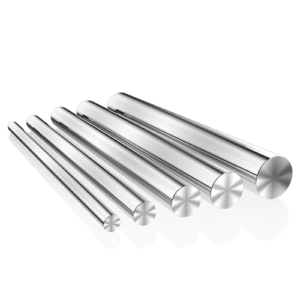Introduction

Stainless steel bars have revolutionized industrial applications worldwide, owing to their exceptional properties and versatility. These bars, crafted from an alloy of iron, chromium, and sometimes nickel, exhibit superior corrosion resistance, high strength, and durability. This blog explores the extensive impact of stainless steel bars across various industries, highlighting their critical roles in manufacturing, construction, transportation, and beyond.
Properties of Stainless Steel Bars
Stainless steel bars possess several key properties that make them indispensable in industrial settings:
- Corrosion Resistance: Stainless steel bar are highly resistant to corrosion, making them ideal for use in environments exposed to moisture, chemicals, and harsh weather conditions. This property ensures longevity and minimal maintenance costs for structures and equipment.
- Strength and Durability: With excellent tensile strength and toughness, stainless steel bar maintain their structural integrity under heavy loads and extreme temperatures. This property is crucial in construction and manufacturing applications where reliability and safety are paramount.
- Heat and Chemical Resistance: Stainless steel bar retain their mechanical properties even at high temperatures, making them suitable for applications in heat exchangers, chemical processing equipment, and automotive components subject to intense heat and corrosive chemicals.
Types of Stainless Steel Bars
Stainless steel bars are available in various forms, each tailored to specific industrial needs:
- Round Bars: Widely used in construction and manufacturing for their ease of machining and uniformity in mechanical properties. Round stainless steel bar are favored for applications requiring precision and structural stability.
- Square Bars: Known for their sharp edges and consistent side lengths, square stainless steel bar are preferred in manufacturing machinery, architectural structures, and decorative applications where aesthetic appeal and mechanical strength are essential.
- Hexagonal Bars: Hexagonal stainless steel bar offer superior grip and stability, making them suitable for applications such as fasteners, shafts, and precision components in machinery and automotive sectors.
Industrial Applications
Stainless steel bars are integral components in diverse industrial sectors:
- Manufacturing: Used in the production of machinery parts, tools, and equipment due to their machining capabilities and resistance to wear and tear.
- Construction: Employed in building frameworks, bridges, and infrastructure projects for their load-bearing capacity, corrosion resistance, and aesthetic appeal.
- Transportation: Essential in automotive manufacturing for engine components, chassis structures, and fuel systems due to their lightweight yet durable nature.
Advancements in Stainless Steel Bar Technology
Recent innovations have enhanced the performance and versatility of stainless steel bars:
- Metallurgical Advances: Improved alloy compositions and refining techniques have resulted in stainless steel bars with enhanced mechanical properties, such as increased tensile strength and hardness.
- Production Techniques: Advanced manufacturing processes, including precision hot rolling and cold drawing, ensure the production of stainless steel bars with tight dimensional tolerances and surface finishes.
- Customization Options: Tailoring stainless steel bars to specific industrial requirements, such as precise diameter tolerances, custom lengths, and specialized surface treatments, enables their optimal performance in various applications.
Case Studies and Success Stories
Real-world examples demonstrate the effectiveness of stainless steel bar in diverse applications:
- Case Study: Manufacturing: A steel fabrication plant optimized its production efficiency by switching to precision-ground stainless steel bar, reducing waste and improving component quality.
- Case Study: Construction: A major infrastructure project utilized stainless steel reinforcing bars to enhance durability and corrosion resistance in coastal environments, prolonging the lifespan of critical structures.
- Case Study: Transportation: An automotive manufacturer integrated lightweight stainless steel bar into its chassis design, achieving significant weight reduction without compromising vehicle safety or performance.
Environmental and Economic Benefits

Stainless steel bars offer substantial environmental and economic advantages:
- Environmental Impact: Stainless steel’s recyclability and longevity reduce material waste and energy consumption associated with frequent replacements, contributing to sustainable development goals.
- Economic Efficiency: Lower maintenance costs, extended service life, and reduced downtime translate into significant cost savings for industries relying on stainless steel bar for critical applications.
Conclusion
In conclusion, stainless steel bars are indispensable components in modern industrial applications, offering unparalleled durability, corrosion resistance, and versatility across diverse sectors. As technological advancements continue to enhance their properties and production techniques, stainless steel bar will continue to drive innovation and sustainability in global industries. Their role in supporting infrastructure, advancing manufacturing capabilities, and ensuring environmental stewardship underscores their enduring importance in the industrial landscape.
FAQ
Q:What are stainless steel bars made of?
A:Stainless steel bars typically consist of iron, chromium, and sometimes nickel, along with other alloying elements for specific properties.
Q:How are stainless steel bar different from other metals?
A:Unlike regular steel, stainless steel bar contain chromium, which forms a passive oxide layer upon exposure to oxygen, enhancing corrosion resistance.
Q:What industries use stainless steel bars the most?
A:Industries such as manufacturing, construction, automotive, aerospace, and chemical processing extensively utilize stainless steel bars due to their durability, strength, and corrosion resistance.
